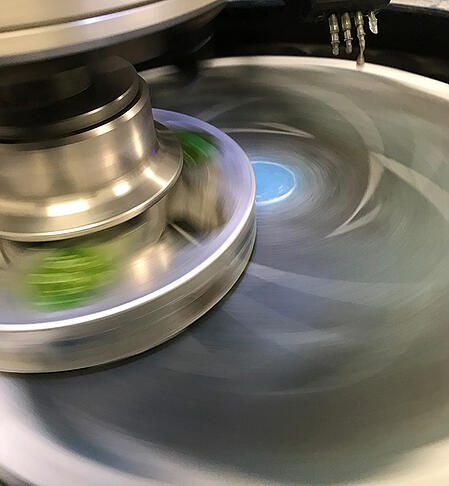WHAT IS METALLOGRAPHY?
Metallography is a specific technique of metallurgical analysis, an examination of metals and alloys, to determine their microstructure at the microscopic level. The resulting data gives insight into phase composition, grain structure, and microscopic material features.
The purpose of metallography is to assess the integrity and overall quality of metals by examining the properties of the sample in relation to the microstructure. By examining the microstructure of metals, you can understand their behavior under certain conditions, their mechanical properties, and the effects of treatments and processing. Metallography plays a critical role in materials science and in, manufacturing and quality control, as they reveal information on processes performed on the material during manufacture and whether or not the materials meet the required specifications to ensure durability in the intended use.
IMR's experienced metallurgists evaluate defects, determine structural features, identify alloys, evaluate the effects of heat treating, and ensure materials characteristics align with specifications. Failure cause analysis services can be provided when material performance doesn't meet specifications.

SAMPLE PREPARATION
In order to be tested, samples must be prepared in advance of microscopic examination.
- Rough/ Final Cutting- Cut specific areas, paying special attention to maintaining sample identification and orientation.
- Mounting- Maintain orientation and select the appropriate mounting medium to optimize edge retention.
- Fixturing- Clamped to maintain planar surfaces during grinding and polishing.
- Grinding and Polishing- Successively finer grinding papers and diamond suspensions for optimal smoothness (to 1 micron)
- Etching- Polished samples are etched with a material-specific etchant to reveal the microstructure
During the evaluation, mounted specimens are examined immediately after drying the etched sample, using an optical microscope at magnifications up to 1000X. Ratings are performed across each surface of interest, with images captured for typical conditions and worst-case field conditions.
METALLOGRAPHY SERVICES LABORATORY Benefits of Using IMR Test Labs
- Metallographic Polishing Techniques - advanced metallurgical analysis with reporting on base metal, alloy, or coatings. A vast array of specialty preparations.
- Expertise - highly trained, experienced, lab technicians, engineers, and metallurgists. Images and data are provided on even the most challenging sample materials.
- Equipment Labs - state-of-the-art, cutting-edge current technologies, including routine microstructure and microhardness testing, electrochemical corrosion simulations, mercurous nitrate testing, and more.
- Quality Assurance - Approvals from Nadcap and A2LA.
RELATED METALLURGICAL ANALYSIS METHODS
Alpha Case
Carburization
Case Depth
Certified Weld Inspections
Coatings Evaluations
Coating Thickness by XRF, SEM, Cross Section
Case Depth
Depth of Decarburization
Determination of Delta Ferrite Content
Determination of Volume Fraction by Point Count
Effective Case Depth
Failure Analysis
Fastener Discontinuities
Fluorescent Impregnation of Porous Coatings
Fractography
Grain Size
Inclusion Content/Rating
Intergranular Attack
Intergranular Oxidation
Light Microscopy - Macro, Micro & SEM Photography
Machining Evaluations
Macroetching
Microetching
Microhardness (Knoop, Vickers, MacroVickers)
Microstructure
Orientation in Microstructure
Particle Analysis (Distribution, ID, Size)
Phase Volume Determination
Plating Evaluations
Plating Thickness
Porosity of Metals, Ceramics & Composites
Prior Austenitic Grain Boundary Determination
Replication (ASTM E1351)
Quantitative Image Analysis
SEM Analysis
Surface Evaluation (Dubpernell Active Site Test ASTM B456 Appx 4)
Surface Topography
Thermal Spray Coating Analysis
Titanium Beta Transus Determination
Weld Qualification & Testing
Corrosion Failure Analysis
Dezincification Testing
Electrochemical Corrosion Testing
Environmental Stress Cracking (ESC)
Formicary (Ant’s Nest) Corrosion Evaluation
General and Pitting Corrosion Testing
Heat & Fluid Aging
Mercurous Nitrate Testing
Passivation Testing of Medical Components
Potentiodynamic Corrosion
Residual and Assembly Stress Testing of Copper Alloys
Sensitization Testing
Stress Corrosion Cracking (SCC)
Metallography is a specific technique of metallurgical analysis, an examination of metals and alloys, to determine their microstructure at the microscopic level.
Metallography data gives insight into phase composition, grain structure, and microscopic material features, in order to assess the integrity and quality of metals, behavior under certain conditions, mechanical properties, and side effects of treatments and processing.
Scanning electron microscopy (SEM), coating evaluation, microhardness testing, microstructural analysis of metals, and microstructural analysis of surface and subsurface damage are metallographic analysis methods.
Metallographic analysis can take a few hours or a few days, depending on the following factors sample complexity and analysis technique. IMR Test Labs has state-of-the-art equipment, metallography experts, and quick turnaround times.
RELEVANT ACCREDITATIONS
Click here for a complete list of accreditations and certifications for all IMR Test Labs locations.


